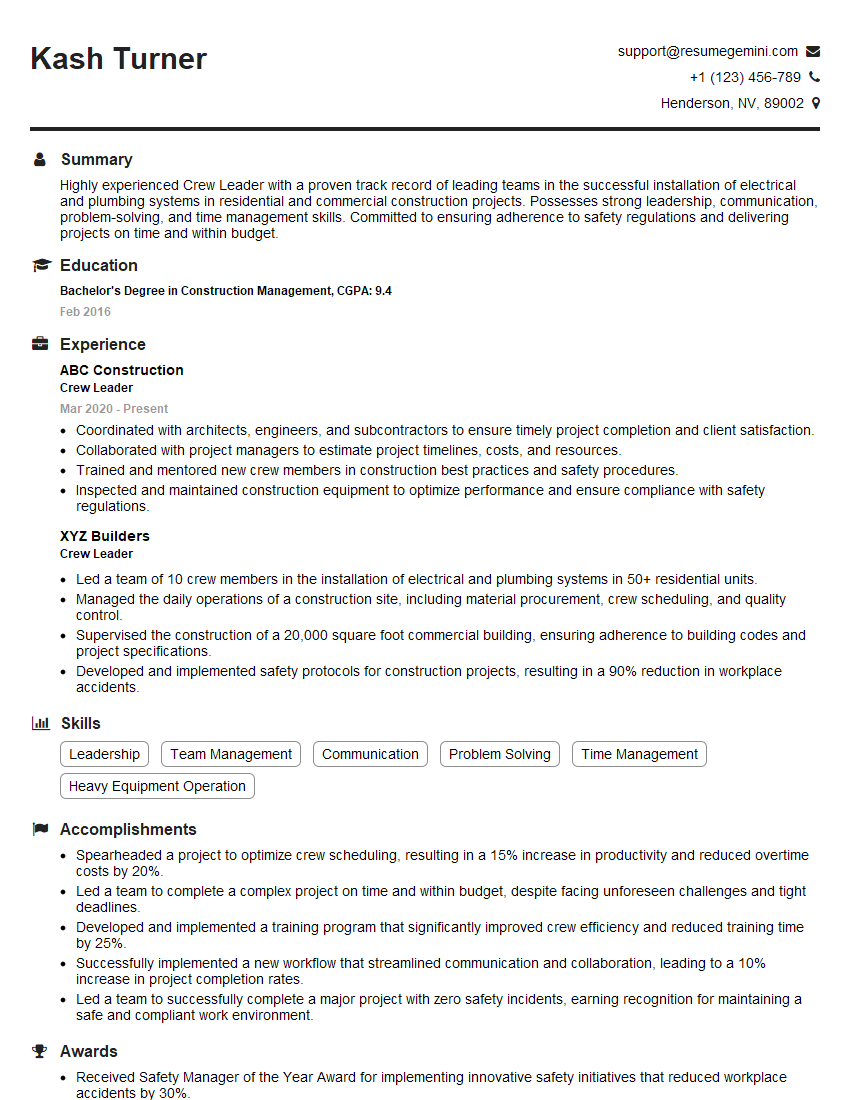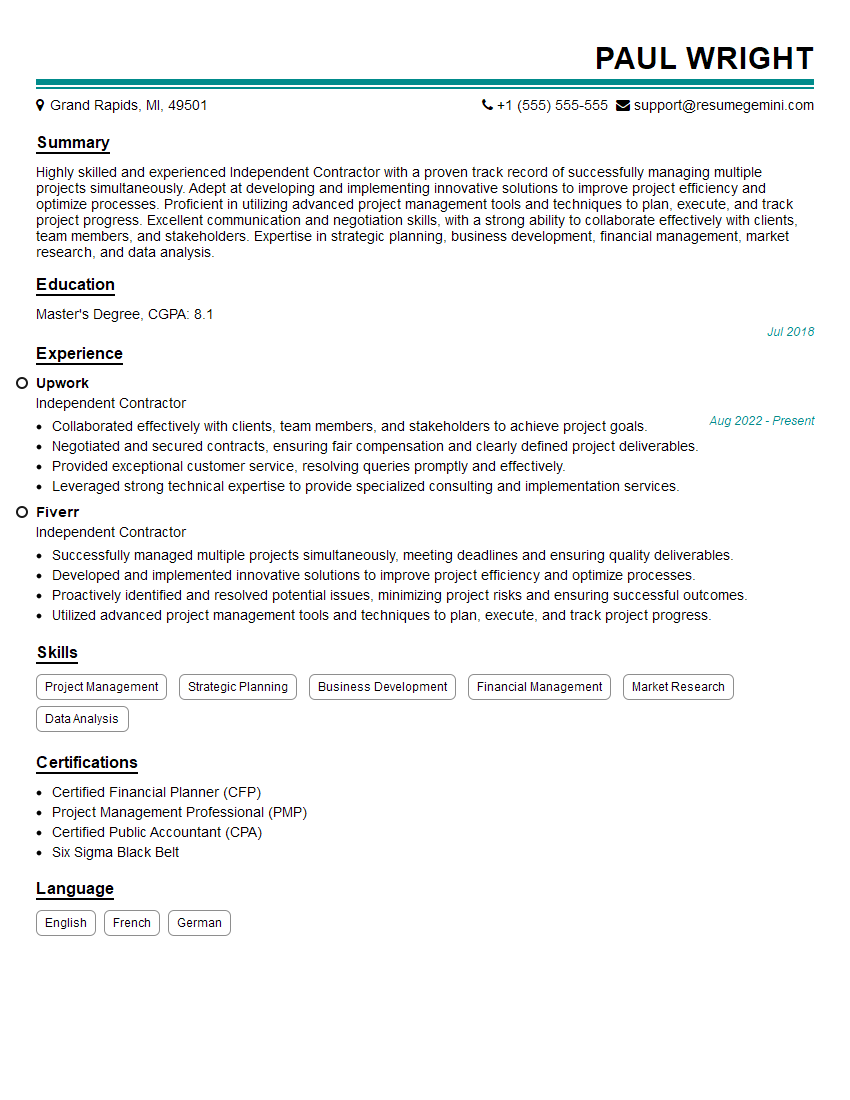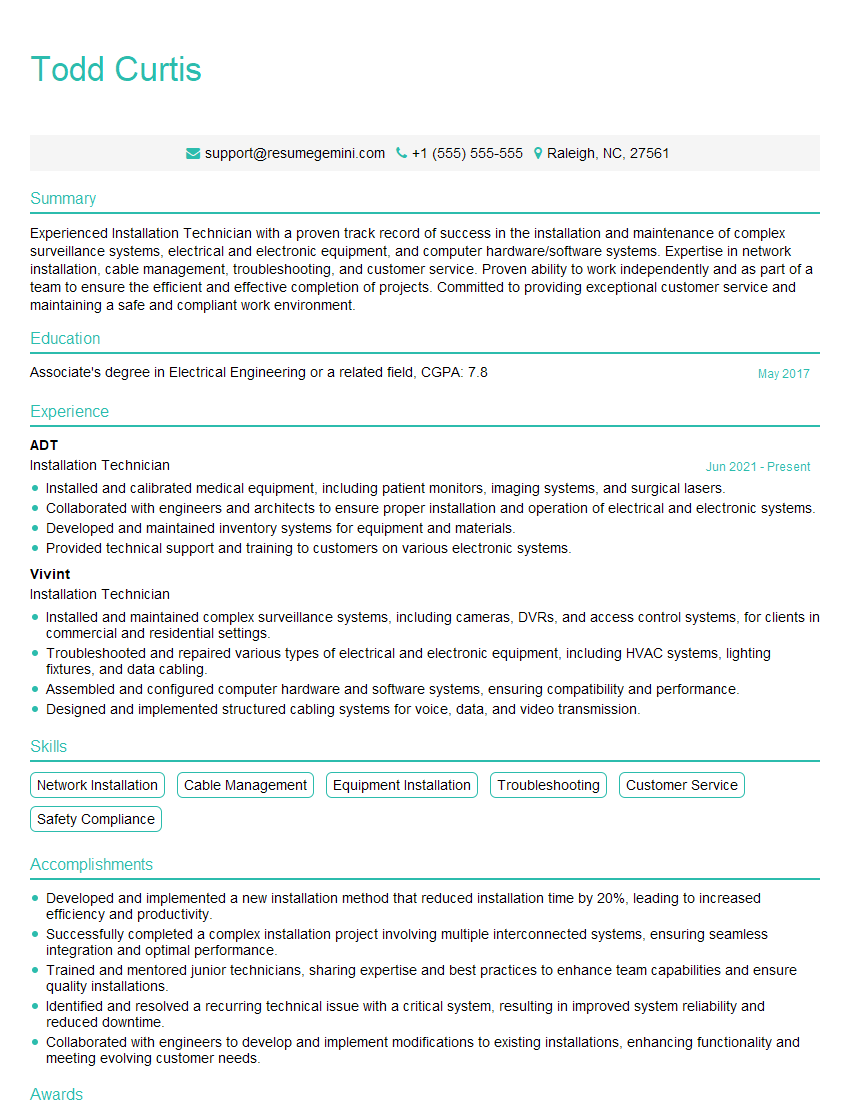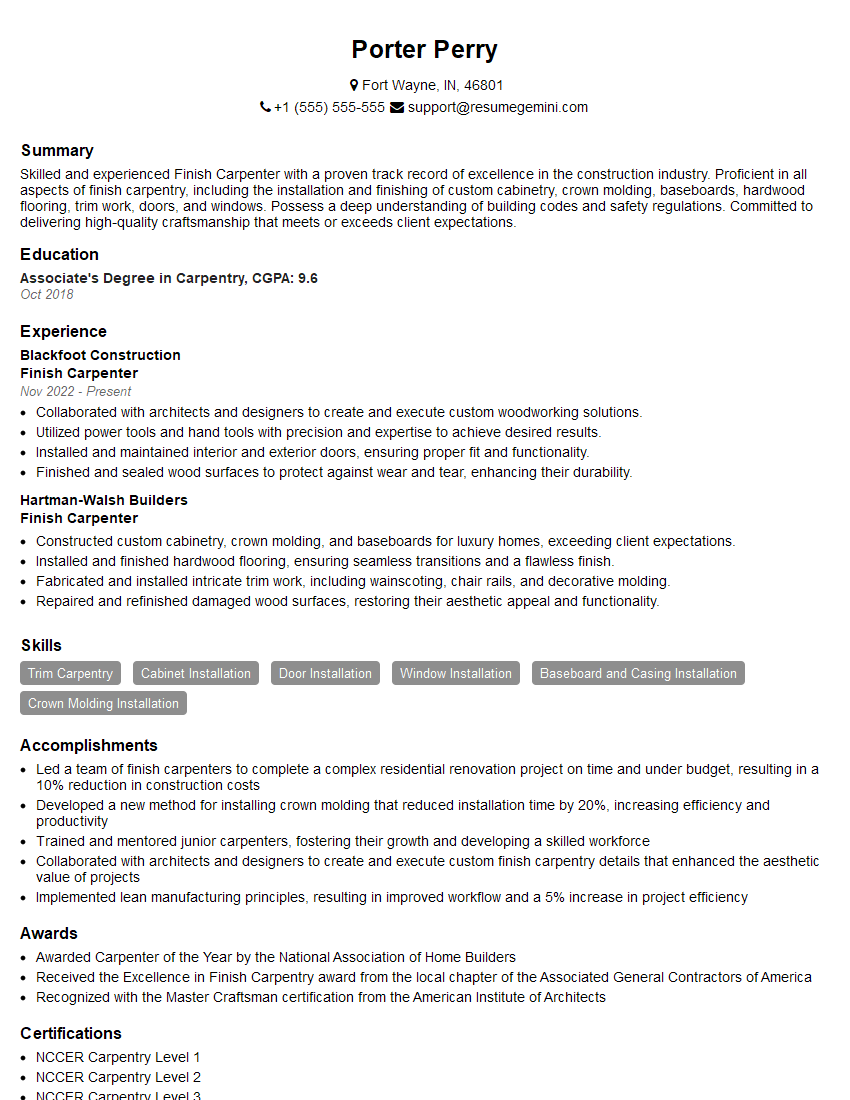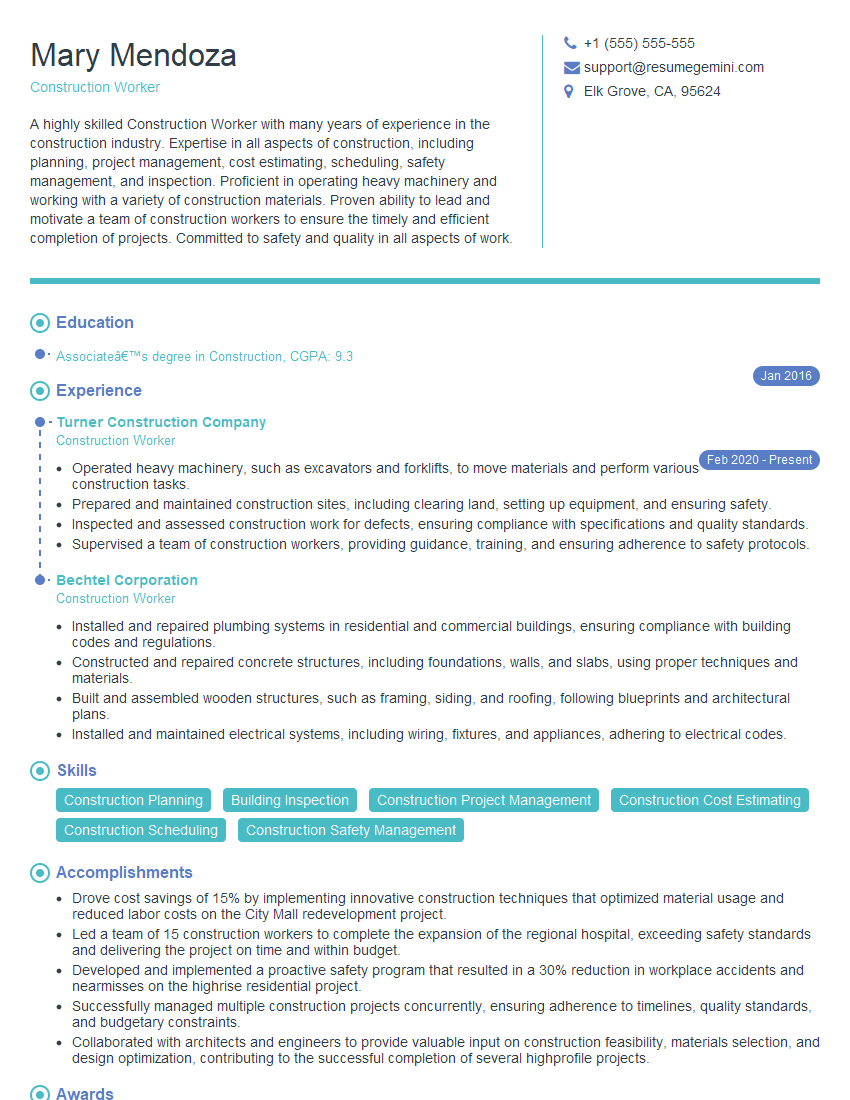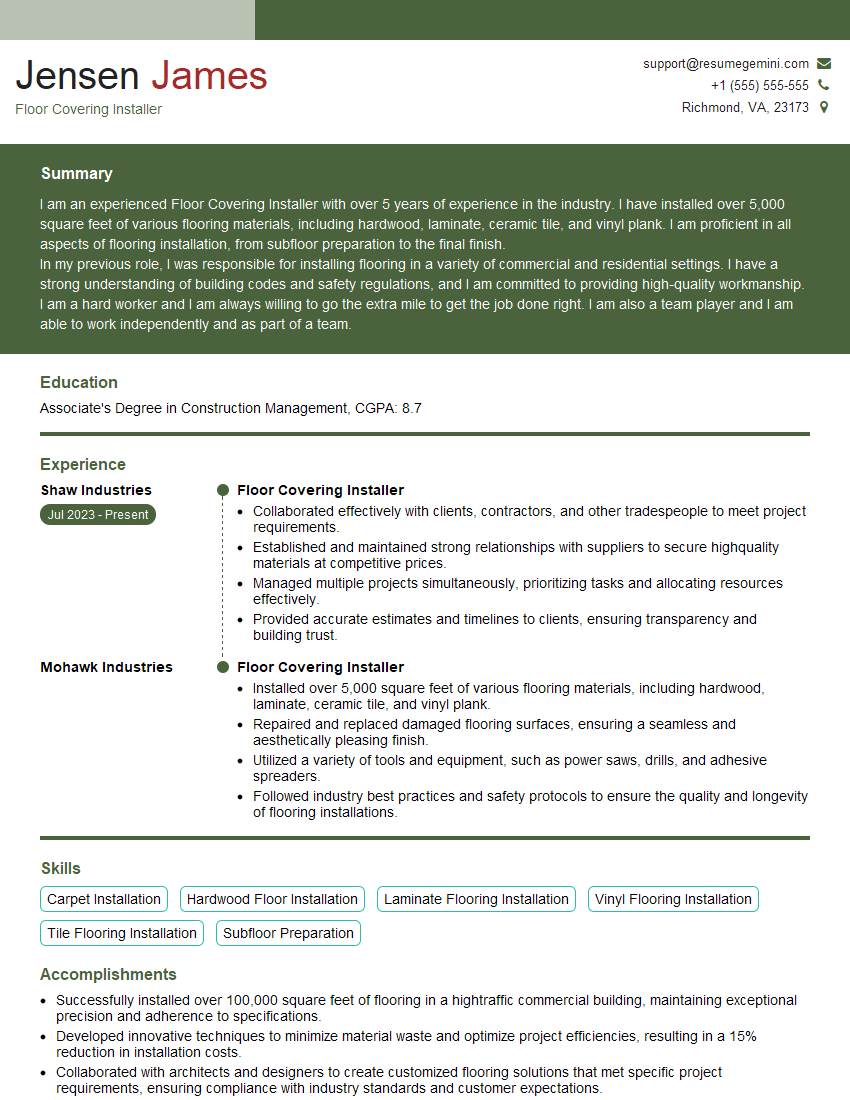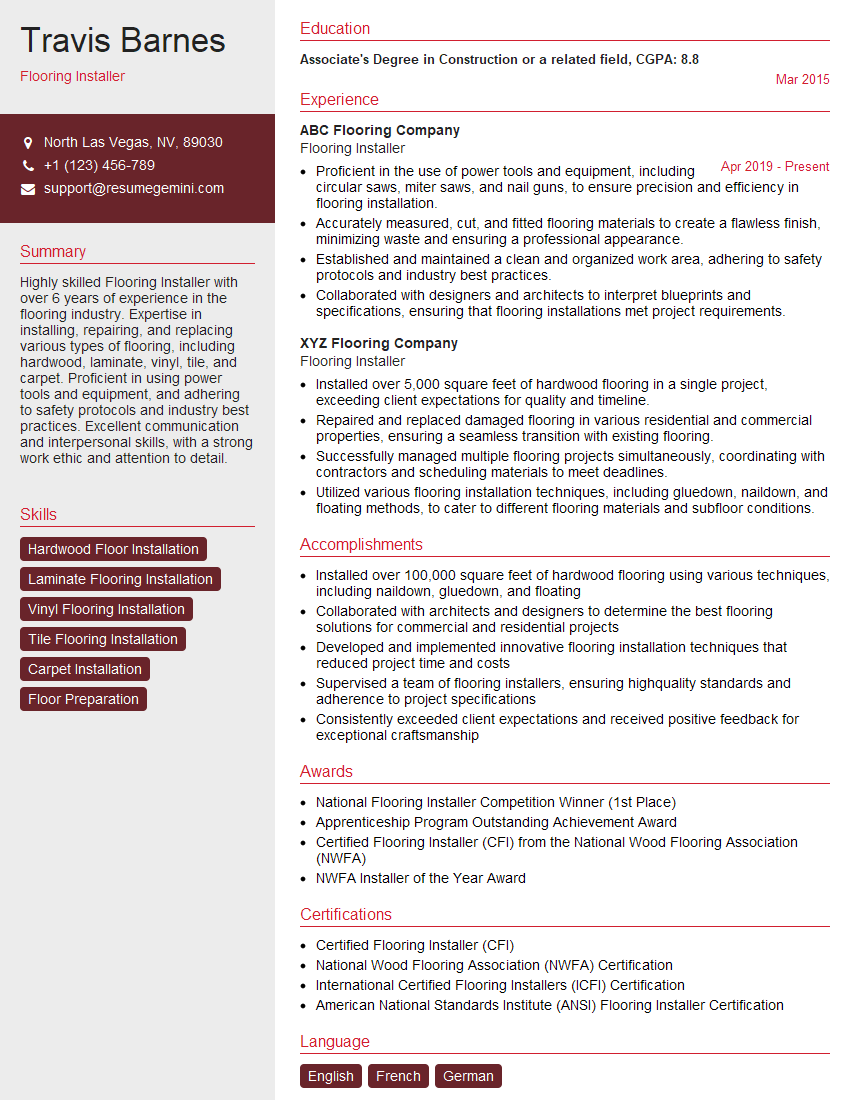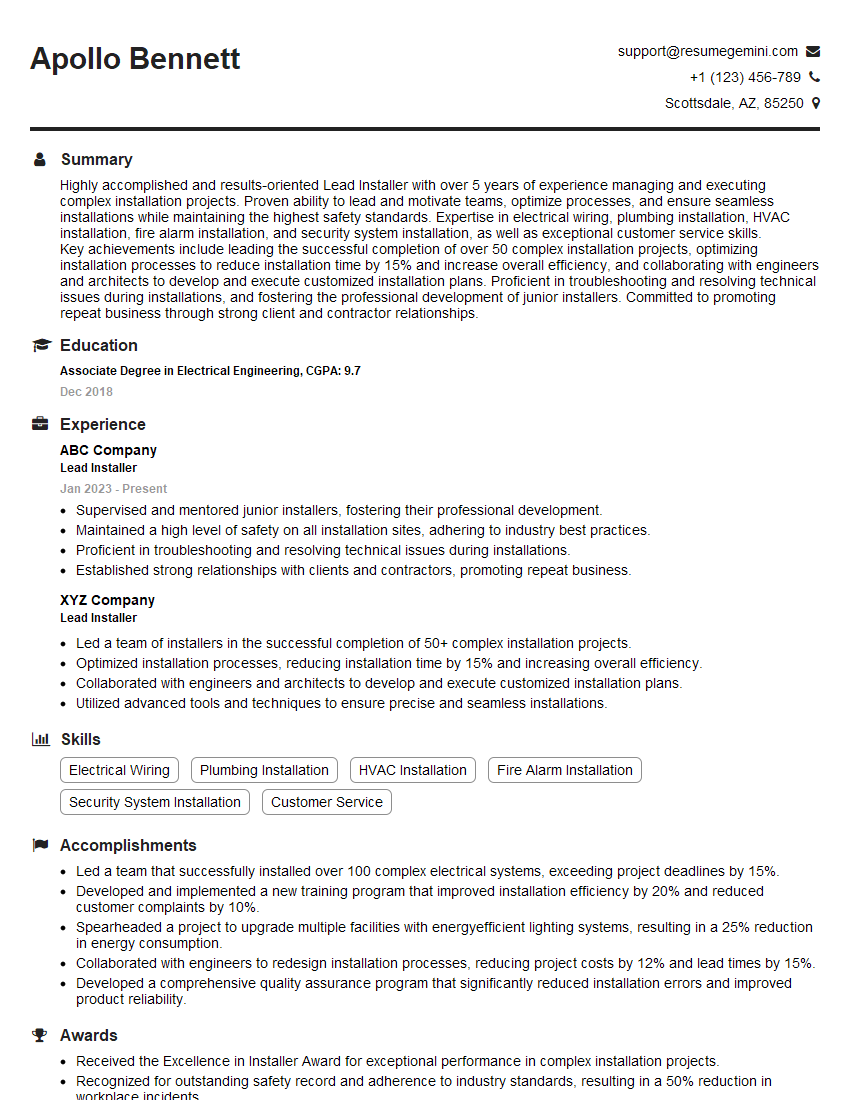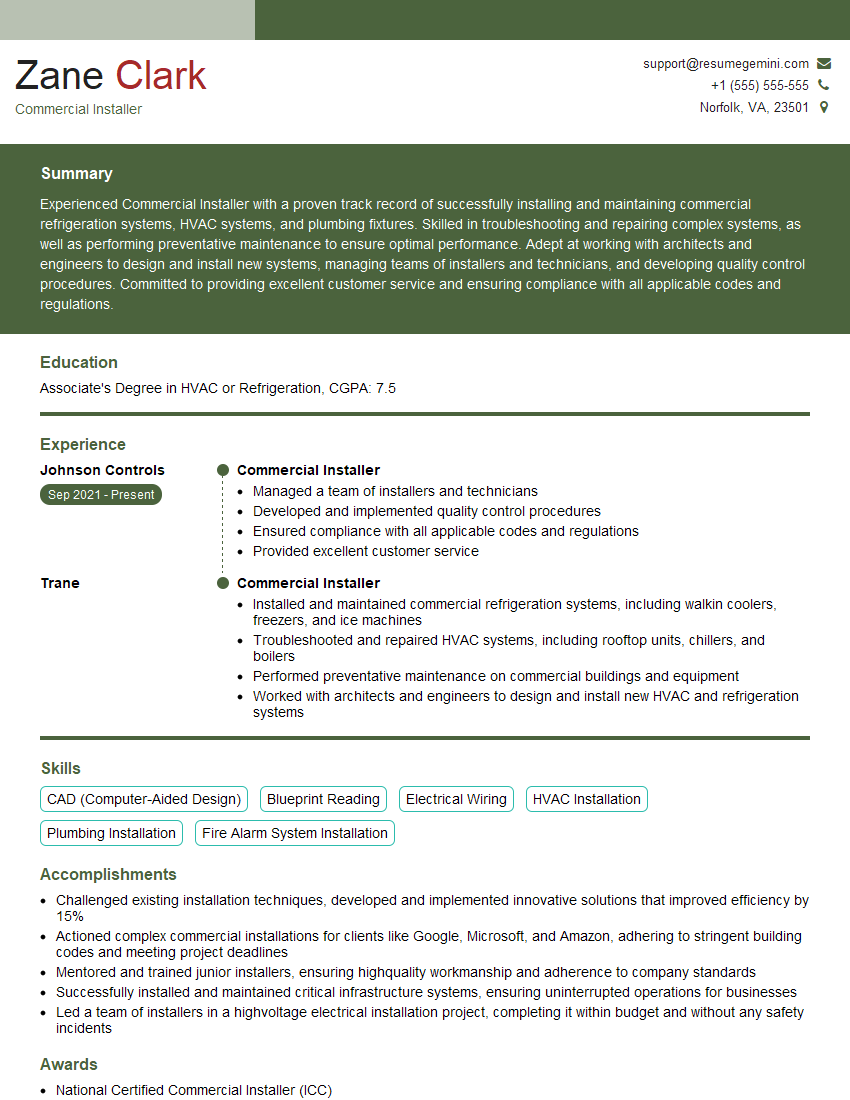Every successful interview starts with knowing what to expect. In this blog, we’ll take you through the top Vinyl Plank Flooring Installation interview questions, breaking them down with expert tips to help you deliver impactful answers. Step into your next interview fully prepared and ready to succeed.
Questions Asked in Vinyl Plank Flooring Installation Interview
Q 1. Describe your experience with different types of vinyl plank flooring (e.g., click-lock, glue-down).
My experience encompasses a wide range of vinyl plank flooring types, primarily focusing on click-lock and glue-down systems. Click-lock planks, with their user-friendly installation method, are excellent for DIY projects and offer quicker installation times. The interlocking mechanism creates a strong, floating floor that’s relatively easy to repair or replace individual planks. However, they’re more sensitive to subfloor imperfections and require a flawlessly level base. Glue-down planks, on the other hand, offer superior durability and water resistance, making them ideal for high-traffic areas and basements. The added adhesive creates a completely stable and rigid floor, minimizing movement and creaking. The installation process is more involved, demanding precision and attention to detail. I’ve worked with various brands and styles, gaining experience in handling different plank thicknesses, textures, and wear layers, ensuring optimal results for each project’s specific needs and budget.
For example, I recently completed a large-scale commercial project using a glue-down system. The client specifically required a highly durable and waterproof floor that could withstand the demands of a busy retail environment. The intricate process of applying adhesive evenly and precisely aligning the planks added time to the project, but the result was a resilient floor with a luxurious appearance.
Q 2. Explain the process of properly acclimating vinyl plank flooring before installation.
Acclimating vinyl plank flooring is crucial to prevent expansion and contraction issues after installation. Think of it like giving the planks time to adjust to their new environment. The process involves storing the unopened boxes of flooring in the room where they’ll be installed for a minimum of 48 hours, ideally 72 hours, at the room’s expected temperature and humidity. This allows the planks to reach equilibrium with their surroundings, minimizing the likelihood of shrinking or expanding after installation. Failure to acclimate can result in gaps appearing between planks or even buckling.
I always emphasize the importance of acclimation to my clients, explaining that this seemingly small step significantly impacts the longevity and aesthetics of their new floor. I’ve personally seen projects where rushed installations without proper acclimation led to costly repairs down the line, highlighting the value of this critical step.
Q 3. What are the crucial steps to ensure a level subfloor for optimal vinyl plank installation?
A level subfloor is paramount for a successful vinyl plank installation. Unevenness can lead to unsightly gaps, buckling, and premature wear. The process starts with a thorough inspection of the existing subfloor. I use a long level to identify any high or low spots. For minor imperfections, I might use self-leveling compound to create a smooth, even surface. For more significant issues like damaged or uneven planks, repairs or complete subfloor replacement may be necessary.
- Inspection: Thoroughly check for high and low spots using a long level and straight edge.
- Repair: Address any structural issues, such as squeaky floorboards or damaged areas.
- Leveling: Use self-leveling compound for minor imperfections, ensuring even distribution and proper drying time.
- Priming (If Necessary): Apply a suitable primer to the subfloor for better adhesion, especially on concrete.
It’s like building a house; you can’t expect a beautiful, stable structure without a solid foundation. Similarly, a flawlessly level subfloor is the cornerstone of a stunning and long-lasting vinyl plank floor.
Q 4. How do you measure and calculate the required amount of vinyl plank flooring for a project?
Accurate measurement is vital to avoid costly material shortages or excessive waste. I start by meticulously measuring the length and width of the room, accounting for any irregularities or obstacles. I then calculate the square footage by multiplying these dimensions. It’s essential to add at least 10% extra to account for cuts, waste, and potential miscalculations, especially in rooms with intricate layouts or many cuts. I always double-check my measurements and calculations to avoid any errors.
For example, in a 10ft x 12ft room, the basic calculation would be 120 sq ft. However, adding 10% (12 sq ft) leads to an order of 132 sq ft. This accounts for cuts around doorways, closets, or other obstacles.
Q 5. What are the common problems encountered during vinyl plank flooring installation, and how do you solve them?
Common problems include uneven subfloors (addressed by leveling), improper acclimation (leading to expansion/contraction issues), and incorrect plank alignment. Gaps between planks can result from inadequate expansion gaps, poor subfloor preparation, or improper installation technique. Buckling often points to moisture issues in the subfloor or insufficient acclimation. Click-lock planks may not click together easily due to debris or improperly cut planks.
My problem-solving approach involves carefully diagnosing the root cause before implementing a solution. For gaps, I might add additional spacers or, in more significant cases, carefully remove and reinstall affected sections. Buckling frequently requires investigation of subfloor moisture. For click-lock issues, thorough cleaning and careful re-cutting planks usually resolve the problem.
Q 6. Describe your experience with different underlayment types and their applications.
Underlayment plays a crucial role in enhancing the performance and longevity of vinyl plank flooring. I’ve worked with various types, each offering distinct benefits. Foam underlayment is common for its cushioning effect, sound dampening, and moisture protection. It’s relatively inexpensive and easy to install. Cork underlayment provides excellent sound insulation and a more comfortable feel underfoot, but it can be more expensive. There are also rubber underlayments which provide more effective cushioning but can be pricier.
The choice depends on the project’s specific needs and budget. For example, in a basement installation, a moisture-resistant underlayment is crucial to protect against potential dampness. In an apartment building, sound dampening underlayment can significantly reduce noise transfer to lower floors. Always consider the subfloor condition when choosing underlayment.
Q 7. How do you handle expansion gaps around doorways and other transitions?
Expansion gaps are essential to accommodate the natural expansion and contraction of the vinyl plank flooring due to temperature and humidity fluctuations. Around doorways, I typically use transition strips that seamlessly blend with the flooring and hide the gap. These strips are designed to cover the expansion gap, providing a smooth transition between flooring and other floor coverings such as carpet or tile. The size of the expansion gap is critical and needs to meet the manufacturer’s specifications, usually ranging from 1/4 to 1/2 inch.
Ignoring expansion gaps can lead to buckling or unevenness as the flooring attempts to expand or contract. Therefore, careful measurement and installation of expansion gaps is a crucial part of the installation process, ensuring a long-lasting and aesthetically pleasing installation.
Q 8. Explain the proper methods for cutting and trimming vinyl plank flooring.
Cutting and trimming vinyl plank flooring requires precision to achieve a clean, professional finish. The most common tools are a sharp utility knife, a circular saw with a fine-tooth blade (for bulk cuts), and a jigsaw (for intricate cuts around obstacles).
For straight cuts, a measuring tape and a straight edge are crucial for accurate marking. Score the plank deeply with the utility knife, then snap it along the score line for a clean break. For curved cuts, use a jigsaw, employing a slow speed and steady hand to avoid chipping. Always ensure the blade is sharp to minimize tear-outs.
Trimming involves making smaller cuts to fit planks around doorways, pipes, or other obstructions. This often requires a combination of scoring, snapping, and using the jigsaw for intricate shaping. Remember to always measure twice and cut once – accuracy is paramount to a successful installation.
For example, when installing around a door frame, I meticulously measure the gap and mark the plank accordingly. I use a jigsaw to create a smooth, precise cut to perfectly fit the plank against the frame, avoiding any visible gaps.
Q 9. What tools and equipment are essential for efficient vinyl plank flooring installation?
Efficient vinyl plank flooring installation demands a range of specialized tools. Beyond the cutting tools mentioned previously, you’ll need:
- Measuring Tape: Accuracy is key. A reliable tape measure is essential for precise measurements throughout the entire process.
- Underlayment: This critical component provides cushioning, moisture protection, and sound dampening. Choose an underlayment appropriate for your subfloor and the type of vinyl plank.
- Spacer Blocks: These maintain consistent expansion gaps between the walls and the flooring, preventing buckling.
- Pull Bar: This tool helps to tightly interlock the planks for a seamless installation. It’s especially helpful in larger rooms.
- Rubber Mallet: Gently tapping planks into place prevents damage while ensuring a secure fit. A hard mallet could easily damage the planks.
- Knee Pads: Comfort and ergonomics are crucial during installation. Knee pads significantly reduce strain.
In addition, a chalk line is useful for marking straight lines for accurate cuts. Depending on the subfloor condition, a self-leveling compound might be needed for uneven surfaces.
Q 10. How do you maintain safety standards during the installation process?
Safety is paramount. I always start by thoroughly inspecting the work area for potential hazards. This includes removing any tripping hazards, ensuring adequate lighting, and securing loose objects.
Proper personal protective equipment (PPE) is non-negotiable. This includes safety glasses to protect against flying debris, gloves to avoid cuts and chemical irritation from adhesives (if applicable), and knee pads for comfort and to avoid strain. A dust mask is also important to protect against breathing in dust from cutting.
When using power tools, I strictly adhere to manufacturer safety instructions and follow all necessary precautions. For instance, I always disconnect power tools before changing blades or making adjustments. Furthermore, I always ensure proper ventilation when working with adhesives.
Maintaining a clean and organized workspace throughout the installation helps avoid accidents. Tools are stored neatly and debris is cleaned up regularly to prevent slipping and tripping.
Q 11. Describe your experience with installing vinyl plank flooring in various environments (e.g., bathrooms, kitchens).
I have extensive experience installing vinyl plank flooring in a wide variety of environments, including bathrooms and kitchens. These locations pose unique challenges due to their higher moisture levels and potential for spills.
In bathrooms, selecting a waterproof vinyl plank is critical. I also pay close attention to proper sealing around the edges of the flooring to prevent water damage. I use moisture barriers and ensure the subfloor is perfectly dry before beginning the installation.
Kitchens require similar consideration regarding moisture, especially around sinks and appliances. I carefully assess the area, making sure the subfloor is completely level and clean before installation. Durable vinyl planks that can withstand the potential impact from dropped items are preferred.
One memorable project involved a high-end kitchen remodel where we used a luxury vinyl plank with an intricate wood-look finish. Precision cutting and meticulous placement were essential to showcase the beauty and quality of the flooring.
Q 12. What is your experience with moisture mitigation in vinyl plank flooring installations?
Moisture mitigation is absolutely crucial for successful vinyl plank flooring installations. High moisture levels can lead to buckling, warping, and mold growth. My approach starts with a thorough assessment of the subfloor’s moisture content using a moisture meter.
If the moisture levels exceed the manufacturer’s recommendations for the specific vinyl plank, I recommend addressing the moisture problem first. This could involve repairing leaks, improving ventilation, or using a desiccant to dry the subfloor. In some cases, it might necessitate employing a vapor barrier underlayment.
Regardless of the subfloor’s moisture level, I always utilize a moisture-resistant underlayment as an extra layer of protection. This helps to create a barrier against moisture that might seep up from the subfloor or enter from spills.
I’ve encountered situations where a seemingly dry subfloor revealed hidden moisture problems. Using a moisture meter saved the day and prevented costly mistakes. The result was a beautiful and long-lasting installation that resisted moisture.
Q 13. How do you address uneven subfloors during installation?
Uneven subfloors are a common challenge in flooring installation. Ignoring this issue will inevitably lead to problems such as uneven surfaces, squeaking, and premature wear of the flooring. My approach involves addressing the subfloor’s imperfections before starting the vinyl plank installation.
For minor imperfections, I often use a self-leveling compound to create a smooth, even surface. This compound fills in low spots and levels out minor dips and bumps, providing a stable base for the vinyl planks.
For more significant unevenness, extensive subfloor repair might be necessary, involving patching, sanding, or even replacing damaged sections of the subfloor. This requires careful evaluation of the subfloor’s condition to determine the appropriate repair strategy.
I had a job once where the subfloor was quite uneven. Using a self-leveling compound took time and patience, but it made all the difference. The finished floor was perfectly level and the client was extremely satisfied.
Q 14. How do you handle transitions between different flooring types?
Transitions between different flooring types require careful planning and execution. The goal is to create a seamless and aesthetically pleasing transition that is also structurally sound.
Common transition methods include using transition strips or reducers. These are specifically designed to bridge the gap between different flooring heights and materials. The type of transition strip selected depends on the height difference between the flooring materials and the overall aesthetic.
Another method is to use a threshold, which is a more substantial piece that sits on top of the flooring. This is a good option for larger height differences. Proper installation of these transitions is essential to prevent tripping hazards and ensure a professional look.
When working on a recent project transitioning from hardwood to vinyl plank, we used a meticulously chosen reducer that blended seamlessly with both flooring types. The outcome was almost invisible, creating a unified and elegant flow throughout the space.
Q 15. What are your preferred methods for cleaning and maintaining vinyl plank floors?
Maintaining vinyl plank floors is surprisingly straightforward, focusing on prevention rather than cure. My preferred method emphasizes regular, light cleaning to avoid build-up.
- Daily Cleaning: A soft-bristled broom or dry mop is ideal for sweeping away loose dirt and debris. This prevents grit from scratching the surface.
- Weekly Cleaning: Damp mopping with a pH-neutral cleaner specifically designed for vinyl flooring is key. Avoid harsh chemicals, abrasive cleaners, or excessive water, as these can damage the planks. I always recommend testing any cleaner on an inconspicuous area first.
- Spot Cleaning: Address spills immediately to prevent staining. For sticky messes, use a slightly damp cloth with a mild detergent, gently blotting the area.
- Deep Cleaning (Quarterly): A steam mop can be used sparingly, ensuring the steam setting isn’t too high. Always follow the manufacturer’s instructions for both the flooring and the cleaning equipment.
Think of it like caring for a well-polished car – regular, gentle care prevents major issues. Ignoring maintenance can lead to dullness, scratches, and potential damage.
Career Expert Tips:
- Ace those interviews! Prepare effectively by reviewing the Top 50 Most Common Interview Questions on ResumeGemini.
- Navigate your job search with confidence! Explore a wide range of Career Tips on ResumeGemini. Learn about common challenges and recommendations to overcome them.
- Craft the perfect resume! Master the Art of Resume Writing with ResumeGemini’s guide. Showcase your unique qualifications and achievements effectively.
- Don’t miss out on holiday savings! Build your dream resume with ResumeGemini’s ATS optimized templates.
Q 16. Describe your experience with installing vinyl plank flooring over existing flooring.
Installing vinyl plank flooring over existing flooring is a common request, and my experience covers a range of situations. The key is careful assessment of the subfloor’s condition.
- Suitable Subfloors: Existing ceramic tile or hardwood floors are usually suitable provided they are level and free from cracks or significant damage. A slightly uneven surface can be mitigated with self-levelling compound but excessive unevenness requires subfloor repair first.
- Unsuitable Subfloors: Carpeted floors, warped wood floors, or subfloors with significant imperfections require removal before installation. Leaving these in place will lead to uneven flooring and compromised long-term stability.
- Preparation is Crucial: Regardless of the existing flooring, thorough cleaning and preparation are essential. This involves sweeping, vacuuming, and removing any loose debris or adhesive residue.
- Moisture Barrier: In many cases, using a moisture barrier underneath is crucial to protect the vinyl planks from any moisture that might seep up from below. This helps maintain the integrity of the installation.
One example was a recent job where we installed vinyl planks over existing ceramic tile. After thorough cleaning, we used a high-quality underlayment designed for this purpose, ensuring a smooth and stable surface. The result was a seamless, beautiful floor.
Q 17. What is your understanding of warranty procedures for vinyl plank flooring?
Warranty procedures vary depending on the manufacturer and the specific product. However, understanding the basics is crucial for both the installer and the homeowner.
- Manufacturer’s Warranty: Each vinyl plank product comes with a manufacturer’s warranty that covers defects in materials and workmanship. These warranties usually specify a timeframe (e.g., 10-25 years) and the conditions required to file a claim. I always advise clients to keep their warranty documentation carefully.
- Installation Impact: Proper installation is often a condition of the warranty. If damage occurs due to improper installation techniques, the warranty may be voided. This highlights the importance of using qualified and experienced installers.
- Filing a Claim: Typically, filing a warranty claim involves documenting the damage with photos, providing proof of purchase, and contacting the manufacturer directly. They will usually guide you through their specific procedure.
- Installer Responsibility: As an installer, I’m also responsible for explaining the warranty terms to my clients and ensuring that the installation adheres to the manufacturer’s guidelines. I take detailed photos throughout the installation process for possible future references and claims.
Understanding the warranty and properly maintaining the floor are crucial for ensuring the long-term value and satisfaction for the client.
Q 18. How do you manage project timelines and budgets effectively?
Managing project timelines and budgets effectively requires a methodical approach. My strategy relies on detailed planning and open communication.
- Detailed Assessment: I begin with a thorough on-site assessment, measuring the area precisely and identifying any potential challenges. This informs accurate material estimations and labor requirements.
- Realistic Scheduling: I create a realistic project timeline, factoring in potential delays due to unforeseen circumstances or material availability. This avoids rush jobs and ensures quality work.
- Budget Transparency: I provide clients with a detailed breakdown of all costs, including materials, labor, and any potential additional expenses. This ensures transparency and prevents unexpected cost overruns.
- Regular Updates: I maintain open communication with clients, providing regular updates on the project’s progress. This fosters trust and allows for prompt addressing of any concerns.
For instance, in one project, we were able to stay under budget by sourcing materials from a slightly less expensive supplier without compromising quality. Effective communication allowed us to adapt to unexpected delays in material delivery, keeping both cost and timelines in control.
Q 19. Describe a time you had to troubleshoot a difficult installation problem.
One challenging installation involved a situation where the subfloor was unexpectedly uneven in a high-traffic area. The initial plan was to use the manufacturer’s recommended self-levelling compound, but it proved insufficient to address the significant height variations.
Troubleshooting Steps:
- Re-assessment: I conducted a more thorough assessment of the subfloor, identifying the exact areas of unevenness and measuring the height variations.
- Alternative Solution: We decided to replace sections of the subfloor instead of relying solely on the self-levelling compound. This ensured a level and stable base for the vinyl plank installation.
- Time Management: While this required additional time and materials, it avoided potential long-term problems like loose planks and unsightly unevenness, maintaining project quality.
- Client Communication: I clearly explained the situation to the client, outlining the revised plan and its implications on the timeline and budget. Their cooperation ensured a smooth resolution.
The result was a perfectly level floor that exceeded expectations despite the initial unexpected challenges. This experience emphasized the importance of adaptability and thorough planning.
Q 20. What are your experience with different types of adhesives and their applications?
My experience encompasses various adhesives, each with specific applications and advantages. The choice depends on factors like the subfloor type, plank type, and environmental conditions.
- Moisture-Cured Urethane (MCU) Adhesives: These are excellent for most applications, offering strong bonds and good moisture resistance. They’re suitable for various subfloors but require proper ventilation during and after application.
- Pressure-Sensitive Adhesives (PSA): These are often used with click-lock vinyl planks, eliminating the need for separate adhesive. They offer convenience and speed but might not be as suitable for uneven subfloors.
- Modified-Silane Adhesives: These are particularly useful in environments with higher moisture levels, offering superior water resistance. They provide a strong bond and are suitable for various subfloor materials.
For instance, in a bathroom installation, I’d opt for a modified-silane adhesive due to its superior moisture resistance. For a quick installation of click-lock planks in a dry basement, a PSA approach may be the most efficient.
Q 21. What safety measures do you take when using power tools during installation?
Safety is paramount when using power tools. My approach involves a multi-layered strategy focused on prevention and mitigation.
- Personal Protective Equipment (PPE): I always wear appropriate PPE, including safety glasses, hearing protection, and work gloves. Dust masks are necessary when cutting or sanding.
- Tool Maintenance: I regularly inspect and maintain all power tools, ensuring they are in good working order and properly calibrated. Dull blades or malfunctioning equipment significantly increase risk.
- Work Area Safety: The work area is meticulously prepared, keeping it clear of obstructions and ensuring adequate lighting. Proper ventilation is crucial when using adhesives or cutting materials.
- Safe Operating Procedures: I strictly adhere to the manufacturer’s instructions for each power tool. This includes understanding and applying appropriate cutting techniques and safety mechanisms.
A recent example involved using a circular saw to cut planks. I ensured the area was clear, used appropriate hearing protection, and maintained a firm grip on the saw to avoid kickback. Safety isn’t just about avoiding accidents; it’s about establishing a systematic and disciplined approach to every task.
Q 22. How do you handle customer communication and concerns?
Customer communication is paramount. I believe in proactive, transparent communication throughout the entire process. Before starting any project, I conduct a thorough site survey with the client, discussing their vision, addressing any concerns, and managing expectations regarding timelines and potential challenges. I provide regular updates during the installation, explaining my progress and addressing any questions or concerns immediately. For example, if unexpected subflooring issues arise, I’ll photograph the problem, explain the solution, and get client approval before proceeding. After completion, I conduct a final walkthrough, ensuring the client is fully satisfied with the work. I also provide clear instructions on how to maintain their new vinyl plank flooring for its longest lifespan.
Q 23. What is your understanding of building codes and regulations related to flooring?
Understanding building codes is crucial for a successful and safe installation. I’m familiar with local and national standards related to moisture barriers, subfloor preparation, and proper installation methods for vinyl plank flooring. This includes understanding requirements for moisture testing of the subfloor (using a moisture meter) before installation to prevent issues like buckling or delamination. For example, I know that certain codes mandate specific types of underlayment based on the subfloor material (concrete, plywood, etc.) and the type of vinyl plank. I always ensure that my work complies with all relevant regulations and obtain necessary permits if required. I also stay updated on changes in building codes through professional development resources.
Q 24. How do you ensure the quality and consistency of your work?
Quality and consistency are achieved through meticulous attention to detail at every stage. This begins with careful subfloor preparation – ensuring it’s level, clean, and dry. I use high-quality materials and tools and follow manufacturer’s installation guidelines precisely. My process includes checking for proper expansion gaps around the perimeter of the room, using appropriate adhesive or click-lock systems, and maintaining consistent spacing between planks. I regularly inspect my work throughout the process, using a straight edge to verify levelness and alignment. I also prioritize clean and organized workspaces to maintain efficiency and minimize damage to the existing property. If there are discrepancies, I’m not afraid to take steps to rectify them immediately. Imagine installing 100 square feet of flooring, only to realize planks are misaligned – it would be better to address this than to complete the work with imperfections.
Q 25. Describe your experience with working as part of a team.
I thrive in team environments. In past projects, I’ve worked collaboratively with other installers, project managers, and subcontractors. Effective communication is key. For example, on a large commercial project, I coordinated with the demolition crew to ensure the subfloor was properly prepared before I began the installation. I also worked closely with the project manager to ensure that materials were delivered on time and that the work stayed within the allocated budget. My collaborative approach helps maintain smooth workflows, ensuring that project timelines are met, and that the final product is of the highest quality.
Q 26. What are your strengths and weaknesses as a vinyl plank installer?
My strengths lie in my meticulous attention to detail, my problem-solving skills, and my commitment to exceeding customer expectations. I’m proficient in various installation methods and adept at troubleshooting unexpected issues. For example, I recently resolved a tricky situation where existing subfloor irregularities needed creative solutions. My weakness, if I had to choose one, is perhaps delegating tasks. I often prefer to handle things myself to ensure quality control, but I’m actively working on improving my delegation skills to enhance team efficiency.
Q 27. Where do you see yourself in 5 years in the flooring industry?
In five years, I see myself as a highly skilled and respected vinyl plank flooring specialist, potentially leading a team or managing projects. I’m committed to continuous learning in this ever-evolving industry. I plan to stay updated on the latest flooring trends and technologies and pursue advanced certifications to broaden my expertise. I’m also exploring the possibility of expanding my knowledge into other flooring types to provide a wider range of services to my clients.
Q 28. What is your salary expectation for this role?
My salary expectation is commensurate with my experience and skillset, reflecting the market rate for experienced vinyl plank flooring installers in this region. I’m open to discussing a competitive compensation package that fairly reflects my contributions to the company.
Key Topics to Learn for Vinyl Plank Flooring Installation Interview
- Subfloor Preparation: Understanding different subfloor types (concrete, plywood, etc.), moisture testing, leveling techniques, and necessary repairs. Practical application: Describing your experience assessing a subfloor’s suitability and addressing any imperfections.
- Acclimation and Material Handling: Proper acclimation procedures for vinyl plank flooring, safe handling and storage techniques to prevent damage, and understanding material specifications (thickness, wear layer, etc.). Practical application: Explaining how you ensure materials are ready for installation and minimizing waste.
- Measurement and Layout: Accurate room measurements, determining optimal plank layout (running bond, straight lay), waste calculation, and material ordering. Practical application: Detailing your approach to planning a flooring installation to maximize efficiency and minimize material waste.
- Installation Techniques: Mastering various installation methods (floating, glue-down), using appropriate tools and adhesives, understanding expansion gaps, and creating professional transitions between different flooring types. Practical application: Describing your experience with different installation methods and the challenges you’ve overcome.
- Troubleshooting and Problem Solving: Identifying and resolving common installation issues (uneven surfaces, gaps, clicks not locking), understanding the causes of common problems, and implementing effective solutions. Practical application: Providing examples of how you’ve identified and solved problems during past installations.
- Safety Procedures and Regulations: Adhering to safety regulations, using appropriate personal protective equipment (PPE), and understanding relevant building codes. Practical application: Demonstrating knowledge of safe work practices and procedures.
- Tools and Equipment: Familiarity with various tools used in vinyl plank flooring installation (measuring tools, cutting tools, installation tools) and their proper usage. Practical application: Demonstrating your expertise in using the tools effectively and efficiently.
Next Steps
Mastering vinyl plank flooring installation opens doors to a rewarding career with opportunities for advancement and specialization. A strong resume is crucial for showcasing your skills and experience to potential employers. Creating an ATS-friendly resume significantly increases your chances of getting your application noticed. We strongly recommend using ResumeGemini to build a professional and effective resume. ResumeGemini provides excellent tools and resources to help you create a compelling resume, and examples of resumes tailored to Vinyl Plank Flooring Installation are available to guide you.
Explore more articles
Users Rating of Our Blogs
Share Your Experience
We value your feedback! Please rate our content and share your thoughts (optional).
What Readers Say About Our Blog
Live Rent Free!
https://bit.ly/LiveRentFREE
Interesting Article, I liked the depth of knowledge you’ve shared.
Helpful, thanks for sharing.
Hi, I represent a social media marketing agency and liked your blog
Hi, I represent an SEO company that specialises in getting you AI citations and higher rankings on Google. I’d like to offer you a 100% free SEO audit for your website. Would you be interested?
